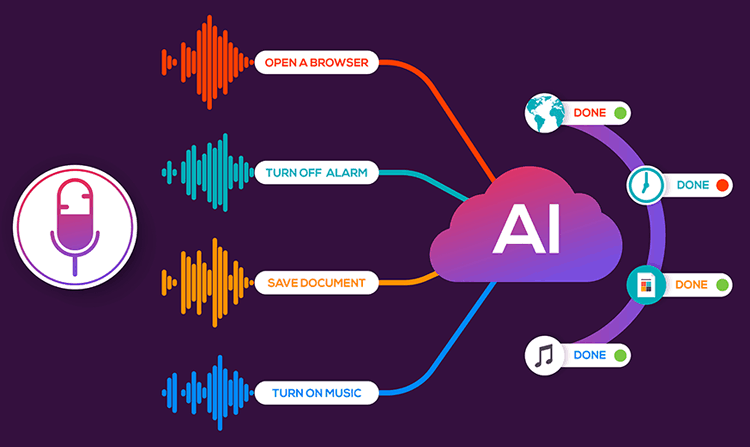Ok, Google. Can you hear me?
The voice search phenomenon is a marvelous one indeed.
Smartphones are now everywhere, and people cannot be bothered to type searches all the time now, can they? This is why voice search is important, and it is also the reason why it is here to stay.
While that may be true, you cannot rule out the fact that text searches still hold a stronger position.

So what’s the point of this article?
As we will discuss in detail below, while text search still stands strong, there is no denying the fact that the percentage of people using voice search has increased significantly in the past couple of years.
To the general user, this competition of-sort hardly matters at all. To marketers, however, it is the primary bone of contention.
In the past couple of years, the focus on search engine optimization prioritized text searches. Marketers were confused about the whole “voice search revolution”. Now in 2019, the answer is clear and marketers are now diverting their focus from text search towards voice search optimization.
Let us look at some stats to get a clearer picture:
● The percentages of voice search use amongst teens are 51% and 41% among adults.● 78% and 76% of both the teen and adult population believe that voice search is safer._
● Both teens and adults alike use it for multi-tasking purposes.
● Primary uses of voice search range from making a call, playing music, and online searches to posting content on social media, controlling a smart home, and making a purchase for the sake of good social media marketing.

The point is that Voice Search is not a pushover.
The question we have to ask ourselves then, is this: Is Voice Search viable?
Once you go through this article, you might find your own answer to this question. If not, our logical conclusion to this question might convince you.
The following is a comprehensive guide to voice search. It is pretty long, so stay with us throughout the article. We will take you step-by-step, hand-in-hand throughout the article so that by the end of this article, you will have a firm grasp on what voice search is and what it will mean for both the general user and the marketer.
Voice Search: The Basics
Why type when you can speak. Voice Search is simply a built-in function for smartphones and desktop OS’s that allows you to search with your voice instead of typing a search query.
While the primary use of voice search is for mobile searches, desktop OS’s have this function as well. To activate the voice search function, usually, you have to say a phrase like “Ok” (Ok, Google, in Google’s case), or “wake”. This activates the voice search. All you have to do now is simply give the voice command of what you want to search. Simple as that.

Other than the “wake” phrases mentioned before, the search results of voice are not that different from what you might type on the keypad/keyboard.
Once you have entered the search term, you will be led to the search engine result pages (SERPs). Again, everything will be the same if you had typed the search query. The only difference is, obviously, the display. A mobile device’s display for a search result will differ from its desktop counterpart.
So, why all this commotion about voice search, you might ask? It is simply the convenience and speed that voice search provides over typing.
So, who is running the show? You might have guessed it: Google.
While Amazon Echo might provide convenient search results for your queries at home, Google has major control over the search engines.
Let us look at how Google’s voice search became what it is today.
Google Voice Search and How It Evolved
Similar to Gmail and Google Drive, Google Voice Search (called Search by Voice) was also a product of Google Labs. Engineers at Google Labs play around with ideas, and it is from those ideas that Google’s Voice Search came into inception.

The first instance of Google’s Voice Search came about in 2010. Back then users had to call a number on their phones to enter a search query. Only then would the users be able to search for what they wished for. The SERP results were generated through the links; however, the total number of search results shown by this tedious process remains unknown.
Being tedious is another matter. The solution was not elegant, and it was not viable, even for 2010. However, it provided insights to the engineers at Google Labs on how they should proceed with the development of this proceeding.
The primary reason why Google’s Voice Search blew up is that Google is a giant. In a few years following the “phone call voice search” experiment, Google launched its Voice Search program. Soon enough, it was integrated with many of Google’s products, like Google Maps, Google Now, and its primary search engine technology.
Fast forward to today, and you can clearly see that voice search is compatible with many of Google’s applications. Not only that, voice search plays a major role in the search experience that Google provides.
Hummingbird and Google Voice Search
It has only been a few years since Google decided to launch the Hummingbird update: a huge change in its traditional search algorithm. The hummingbird update led to a significant change in how we think about search and search engine optimization.
The fundamental elements that changed with Hummingbird were the focus towards the semantic search experience. Semantic search is the implied meaning within search queries.
The context of the search from the user’s end is important to search, but for machines, it is rather difficult to understand the semantic meaning behind the keywords. This is the reason why focus on semantics in the update was important, it gave Google the ability to determine user intention behind a particularly vague search, and at the end of the day, provide users with a better search experience.
So How Does Semantic Search Work?
Let us give you a demonstration. Of course, our search would be conducted through Google’s Voice Search option.

Let us give you a demonstration. Of course, our search would be conducted through Google’s Voice Search option.
Suppose you conduct a search for “Josh Brolin”, the actor famous for his roles in The Goonies, Oldboy, and Avengers: Infinity War.
Simple enough the query would return all the answers for Josh Brolin and his film career.
But what if you provided Google with information that is ambiguous to the search engine. For example, instead of typing “Josh Brolin”, you decide to write “What role does he play?”
Now Google will struggle with this because the information is ambiguous.
Instead of the desired results for Thanos, we actually get a bunch of different characters i.e. a range of characters instead of the character in question.
Google does a good job of providing this information, but it works even better when asked about real people, instead of their aliases or, in our case, the characters they play.
Now, if we perform the above search sequentially, Google knows we are interested in Josh Brolin’s character in Infinity War, so it fills the gap and understands for itself. Eventually, it gives us the desired results, regardless of the ambiguity of the search.
Once Google has a semantic grasp of what you are looking for, things get pretty easy. Even the vaguest information now has context.
This is perhaps the best example of semantic search that we can give you. You can check it out for yourself too by typing in vague searches. Once you provide Google with a bit of context, it works by itself and provides you clarification on everything. It understands each question with intuitiveness and provides you the search results.
You might notice but at the end of the day, Google did its level best to provide you a wonderful, more natural, search experience
Why Optimize for Voice Search?
With all that we have discussed in the previous section, it is pretty clear that voice is not just another fad; it is a phenomenon that is here to stay.

The question is, are you prepared for voice search?
If you are not, then you could be losing market share against your competitors. Competitors who have put in the time and effort to optimize their websites for voice search.
But all is not lost yet. You can still optimize your website for voice search.
The following section digs deeper into the world of voice search by first introducing the current giants in the voice search industry. We will show you just how heavily tech giants are investing in voice search.
Once you have a solid grasp on the current state of voice search technology, we will show you how you can optimize your site for voice search.
So What Did Voice Search Really Do?
When Google started their “mobile-first” approach to websites, some webmasters relaxed thinking that their desktop versions would be enough. But when reality kicked in, they realized their folly and started optimizing for the mobile version. For some, it was too late, but for others, they barely made it.
In the past few years, we have seen a similar situation. Webmasters are thinking that voice search is just a hoax. The statistics, however, paint a different picture. ComScore says that by 2020, half of the searches will be done through voice

This statistic, while being a “50-50” proposition does shed light on a trend. If not 2020, voice searches could be a thing afterward. The present state of voice search technology is certainly an indication of such a trend’s possibility. Let us look at some of the popular voice search devices.
Google Assistant
If you have an android, you wouldn’t be a stranger to Google Assistant. It’s the app that activates when you say the words “Hey Google?”.
It should be pretty clear by now that Google Assistant conducts searches through the main index of Google Search. Once you voice your query, it responds verbally by providing you the most relevant search results. Simply put, you do not have to type, just say the word and Google Assistant does it for you.
Besides the basic search functions, Google Assistant also has Google Actions. What Google Actions do is that it converts the entire search experience into a conversation. Best use cases for Google Actions include asking Google to open your garage door, turn the lights on, locking the door, and so on.
You can set prompts for Google Actions using its Actions Console that works just like the Google Search Console. There are templates available within Google Actions that let you build Google Actions.
Simply put, Google Actions is like an app within an app.
Google Home & Hub
As far as Google Assistant is concerned, you had to download the application for it works, right? Google Home is a bit different because it is an IoT device that comes pre-installed with Google Assistant.
Think of a small speaker, and now think of Google Home. The only difference is that Google Home does more than just play music.

Google Home Hub, however, is a totally different ball game. It is Google Home but with a screen.
Want to try out the latest chicken recipe by Gordon Ramsey but can’t follow the verbal instructions of Google Home? Google Home Hub’s got your back with a video tutorial that will help you cook without mishaps.
We were going to talk about this later on, but a teaser here would prove useful.
“How-To” instructional videos are rising on YouTube. At the recent Google I/O, Google made it clear that Home Hub gives precedence to YouTube videos. If you are a YouTuber that makes “How-To” videos, it is important that you capitalize on this information, and fill in missing information around your business, brand, or channel.
It is no surprise that Google gives precedence to its apps and platforms for Google Hub. So it is important that you optimize for Google’s assets first.
Alexa by Amazon
You would think that Apple would be the prime competitor of Google’s voice tech. This time, it is actually Amazon with its Alexa virtual assistant.

In terms of functionality, it works just like Google Assistant. Being a product from Amazon, however, it lets you shop and place orders directly on Amazon without having to turn to Google for a search.
Being a digital assistant, it answers your queries not through Google, but Bing. While Bing might have come as a shock to you considering its position as a search engine over the years, the fact of the matter is that Bing is having, or will have its moment in the near future.
As a marketer, it should not come as a surprise that you would have to learn Bing Webmaster Tools and optimize voice searches for the Bing Search Engine.
Similar to Google Actions in the previous discussion, Alexa also has an in-product feature. Introducing Alexa Skills.
Alexa Skills is a voice recognition tool in the “cloud” that provides search results that best suit the user’s query. In Amazon’s context, the search results are actually called “skills”.
Amazon is certainly working its way to the top by combining both voice search and cloud technology.
Amazon Echo
If you haven’t guessed it by now, we’ll fill you in. Yes, Echo is the Google Home of Amazon. It helps users connect to the Amazon Alexa platform.
We know what you are thinking. Maybe Echo stole the idea from Google. While Google might have innovated voice search technology, Amazon has been the silent pioneer in the field. Amazon Alexa was introduced in 2014, while Google Home came out in 2016. Besides that, Amazon also has the Echo Dot and Echo Show, two powerful home assistants.

Apple Siri
Even non-iPhone users aren’t stranger to Apple’s Siri. Embedded in every iPhone, just give Siri a command it will return a result or results, for that matter.
The only difference is that Siri returns search results, not audible results.
Siri is indeed a powerful application. Available only the iOS platform, of course, Siri has Siri Shortcuts, which works just like Google Actions. Siri Shortcuts help you keep track of everyday tasks, records your routines, and suggests you various options on the basis of it.
Apple HomePod
With Google Home, Google had the upper hand. Apple replied with the Apple HomePod. Released in mid-2017, the HomePod has the same features you would expect from it. The only problem with it is that Apple still hasn’t introduced a smart display for the HomePod.
Microsoft Cortana
The OS giant Microsoft has also entered into the voice assistant market with Cortana, the intelligent assistant that lets you “achieve less with more”. Similar to Alexa, the search results that Cortana provides come not from Google, but Bing.
How To Optimize For Voice Search
Now that we have talked about the various digital assistants, it is time to get into the crux of this section: how to optimize for voice search. Here are a few tips to get you started:
Focus on Conversations
With traditional search, you used keywords for optimization. With voice search, you have to look at search from the user’s perspective.

Optimizing for a keyword like “top mobile app development companies” will not work because it feels like something that users would type on the keyword.
Instead, focus on a question that the user might have, like “Where can I find the best mobile app development services in my area”? That might do the trick for you because voice search is asking questions and finding the answers.
Focus On The Speed Of Your Website
Nothing new to do here, it is just the plain old search engine optimization technique. Be that as it may, be, voice search will favor sites that respond and load quickly.
You focus, therefore, should be towards mobile responsiveness, image optimization, file compression, websites cache, and server response timings. Pretty much everything that might have applied to traditional SEO can be applied to voice search SEO.
Featured Snippets Are Important

Optimizing for a keyword like “top mobile app development companies” will not work because it feels like something that users would type on the keyword.
Instead, focus on a question that the user might have, like “Where can I find the best mobile app development services in my area”? That might do the trick for you because voice search is asking questions and finding the answers.
Focus On The Speed Of Your Website
Nothing new to do here, it is just the plain old search engine optimization technique. Be that as it may, be, voice search will favor sites that respond and load quickly.
You focus, therefore, should be towards mobile responsiveness, image optimization, file compression, websites cache, and server response timings. Pretty much everything that might have applied to traditional SEO can be applied to voice search SEO.
Local Searches and Voice Search
Voice search queries are primarily used for “near me” searches since 22% of the queries conducted through voice search are location-based. Investing in local content, is, therefore, important.
Just like the example in the first tip, you can mix it up with “best XYZ service or product near me” or “best service or product in my area”.
Conclusion
Now that you have reached the end of this article, you might ask whether or not voice search will actually improve my ranking. The answer is that you might not see a substantial rise in analytics reports, but then again, you might notice an improvement in brand awareness. This eventually leads to an improvement in the number of online purchases.
Don’t take it from us. Amazon eCommerce revenues through voice search were $1.8 billion. Being Amazon, the figure is only expected to rise by 2022.
Optimizing your site for voice search, therefore, will prove beneficial in the long run for you in terms of competition.







